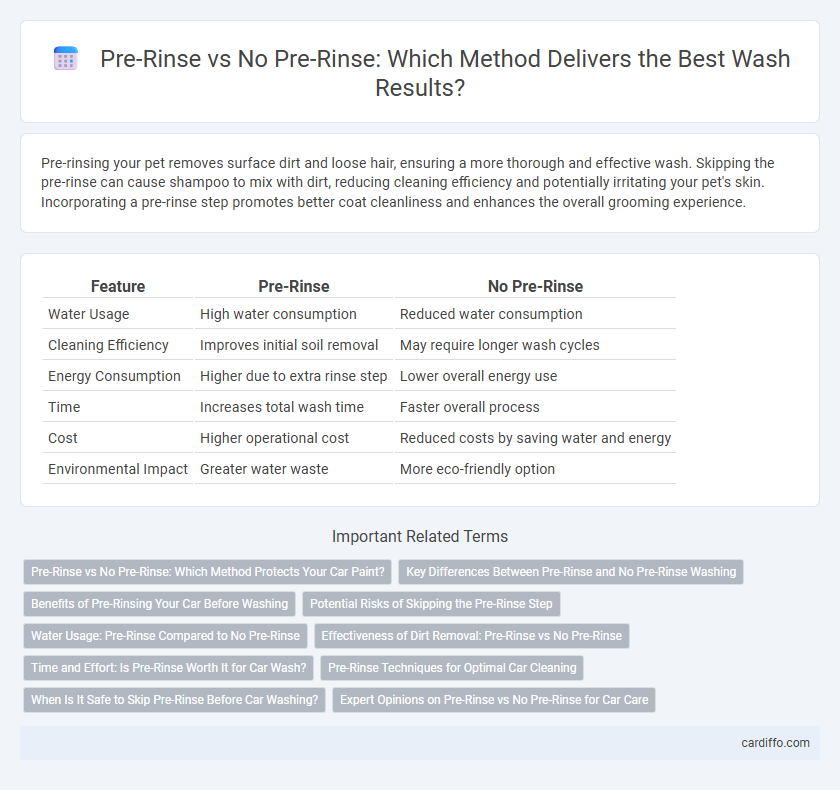Pre-rinsing your pet removes surface dirt and loose hair, ensuring a more thorough and effective wash. Skipping the pre-rinse can cause shampoo to mix with dirt, reducing cleaning efficiency and potentially irritating your pet's skin. Incorporating a pre-rinse step promotes better coat cleanliness and enhances the overall grooming experience.
Table of Comparison
| Feature | Pre-Rinse | No Pre-Rinse |
|---|---|---|
| Water Usage | High water consumption | Reduced water consumption |
| Cleaning Efficiency | Improves initial soil removal | May require longer wash cycles |
| Energy Consumption | Higher due to extra rinse step | Lower overall energy use |
| Time | Increases total wash time | Faster overall process |
| Cost | Higher operational cost | Reduced costs by saving water and energy |
| Environmental Impact | Greater water waste | More eco-friendly option |
Pre-Rinse vs No Pre-Rinse: Which Method Protects Your Car Paint?
Pre-rinsing your car removes loose dirt and contaminants, reducing the risk of scratching and paint damage during washing. Skipping the pre-rinse leaves abrasive particles on the surface, increasing the chances of swirl marks and micro-scratches. Research and expert advice favor pre-rinse as the safer method to preserve your car's clear coat and paint finish.
Key Differences Between Pre-Rinse and No Pre-Rinse Washing
Pre-rinse washing involves an initial spray or soak to remove loose food particles, improving the efficiency of detergent action and reducing staining on dishes. No pre-rinse washing skips this step, relying on the detergent and wash cycle to break down residue, which can save water but may require stronger detergents or longer wash times. Key differences include water usage, cleaning effectiveness on heavily soiled items, and energy consumption, with pre-rinse generally providing better results for tough grime but higher resource use.
Benefits of Pre-Rinsing Your Car Before Washing
Pre-rinsing your car removes loose dirt, grime, and contaminants that can cause scratches during the wash process, preserving the paint's finish. It improves the effectiveness of car wash soap by softening stubborn residues, resulting in a more thorough and efficient clean. Pre-rinsing also helps conserve water by reducing the need for multiple wash cycles to remove dirt buildup.
Potential Risks of Skipping the Pre-Rinse Step
Skipping the pre-rinse step in dishwashing can lead to food residue buildup, increasing the risk of bacterial growth and cross-contamination. Residual grease and particles may clog dishwashers or reduce detergent effectiveness, causing suboptimal cleaning results. In commercial kitchens, neglecting pre-rinse can compromise sanitation standards and result in health code violations.
Water Usage: Pre-Rinse Compared to No Pre-Rinse
Pre-rinsing dishes can use up to 20 gallons of water per load, significantly increasing overall water consumption compared to no pre-rinse methods. Modern dishwashers are designed to remove food residues effectively without pre-rinsing, reducing water usage by approximately 30-50%. Eliminating pre-rinse not only conserves water but also lowers utility bills and supports sustainable water management practices.
Effectiveness of Dirt Removal: Pre-Rinse vs No Pre-Rinse
Pre-rinsing significantly enhances dirt removal by loosening and rinsing away food residues before the main wash cycle, resulting in cleaner surfaces and reduced soil buildup. Without pre-rinse, detergents must work harder to break down stuck-on grime, often leading to incomplete cleaning and more frequent need for rewashing. Studies show that pre-rinse can improve overall cleanliness by up to 30%, especially in commercial kitchens where heavy soiling is common.
Time and Effort: Is Pre-Rinse Worth It for Car Wash?
Pre-rinsing a car before the main wash significantly reduces cleaning time by loosening dirt and grime, making soap application and rinsing more efficient. Skipping the pre-rinse can increase effort and extend the washing process due to stubborn residues requiring extra scrubbing. Investing a few minutes in pre-rinsing optimizes overall workflow and results in a more effective, time-saving car wash.
Pre-Rinse Techniques for Optimal Car Cleaning
Pre-rinse techniques significantly enhance car cleaning by loosening dirt, grime, and road contaminants before applying soap, reducing the risk of scratches during washing. Using high-pressure water jets or foaming pre-rinse sprays improves the efficiency of dirt removal while preserving the vehicle's paintwork integrity. Studies show that an effective pre-rinse can cut cleaning time by up to 30% and extend the lifespan of wax and sealants on automotive surfaces.
When Is It Safe to Skip Pre-Rinse Before Car Washing?
Skipping the pre-rinse before car washing is safe when the vehicle has minimal dirt, dust, or loose debris that won't scratch the paint during washing. Modern pH-balanced car shampoos and foam cannons effectively loosen grime without the need for a pre-rinse, especially if the car was recently washed or stored indoors. Avoid skipping pre-rinse if the car has caked mud, bird droppings, or heavy road salt, as these contaminants can cause scratches or damage without initial rinsing.
Expert Opinions on Pre-Rinse vs No Pre-Rinse for Car Care
Expert opinions on pre-rinse versus no pre-rinse for car care emphasize the importance of removing loose dirt and debris before washing to prevent swirl marks and surface scratches. Professional detailers commonly recommend a pre-rinse with high-pressure water to enhance the effectiveness of soaps and reduce contaminants. Some experts argue that skipping the pre-rinse risks embedding particles into the paint, leading to damage and less optimal cleaning results.
pre-rinse vs no pre-rinse Infographic

 cardiffo.com
cardiffo.com